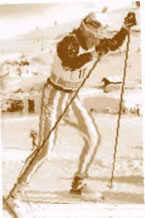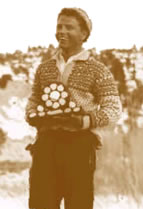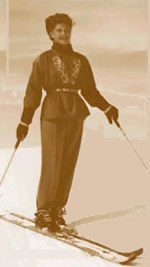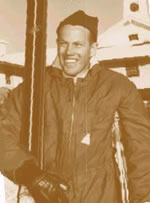THROUGH THE YEARS
Once an individual has acquired the title of “Olympian,” it is his or hers forever. The University of Utah has had in its ranks such athletes who have earned that title through talent and skill, hard work, commitment, and dedication. A select few of these alumni are featured in this issue’s “Through the Years” section.
| Richard D. Movitz | Suzanne Harris Rytting | Marvin A. Melville | William Allen Spencer |
| Peter Karns | Curtis R. Canning | Luke Bodensteiner | Alan Engen |
LM: Life Member AM: Annual Member
|
Richard
D. Movitz BS’49 was involved for a number of years
in Olympic and world skiing events. Movitz’s ski racing
career ended after that, but in the late 1950s he became a part
of the U.S. Ski Association and was chair of the International With his skiing career
behind him, Movitz joined his father’s importing business,
from which he retired in 1996. He still keeps in close contact with
the U as a fan and a generous donor. He will be enjoying the 2002
Games from his home in Holladay, Utah. AM |
|
Suzanne
Harris Rytting ex’51 (better known as Suzy)
began skiing at the age of 13 and started racing with the Salt Lake
City East High team at the age of 15. Her first Olympic experience was as second alternate with the 1948 team in St. Moritz, Switzerland. She was named to the 1952 team for the Oslo Games after placing fifth in the downhill, second in slalom, and fourth in combined in the Olympic tryouts at Sun Valley, Idaho. Before she could compete, Olympic officials discharged her from the team when it was revealed that the flu-like symptoms she was experiencing were, in fact, the first signs of morning sickness in her two-week-old pregnancy. Despite doctors’ assurances that she could compete, the officials would not allow it.
|
|
Marvin
A. Melville BS’59 is an icon in the skiing
world. In honor of his many accomplishments, he was In 1961 Melville turned
his attention to teaching. Along with two other ski enthusiasts,
he organized the Alpine Training School for junior ski racers in
Salt Lake City. In sessions at various junior and senior high schools,
the young students would practice on dry land, skiing year-around.
With homes in Salt Lake
City and in Sun Valley, Idaho, Melville is still teaching skiing—to
his five children and 27 grandchildren. AM |
|
Spencer is now assistant
chief of competition for biathlon at Soldier Hollow in Wasatch State
Park, Heber City, Utah, and will help conduct the biathlon programs
in the 2002 Olympic Winter Games. He is also a member of the J.
Willard Marriott Library Ski Archives Advisory Board. He is married
to Judith Spencer BS’72.
LM |
| Peter
Karns BS’67 holds two records for best finishes
by an American in biathlon set during the 1972 Jackson Hole, Wyoming,
is home to Karns and his wife, Jeanine, and his Real Estate of Jackson
Hole brokerage. Their three children are all skiers. |
|
Ultimately, Canning became Harvard’s 95th heavyweight crew captain his senior year, and he managed to hold down his job and graduate magna cum laude, as well. His team participated in the Pan Am Games, the North American Championships in St. Catherines (Ontario), the European Championships in Vichy, France, and the Olympic Games in Mexico City (see And Finally).
A psychiatrist practicing in Logan, Utah, Canning is currently president of the Utah Psychiatric Association. He is married to Rebecca Petersen Canning MEd’73. While rowing may seem a million miles away, there are reminders of competitions past—an oar from the Pan Am Games tacked on a wall in his home, and occasional reunions of the Harvard ’68 crew of eight. AM
|
Luke
Bodensteiner BA’94 is another repeat Olympian, having competed
in the 1992 and 1994 games.
 A
cross-country skier, he raced in three different distances in 1992
and in four different distances in 1994. As a member of the U ski
team from 1989-1993, he won the NCAA championship twice as an individual
and once with his team, then took a leave from school in 1992 and
1994 when he raced overseas in the World Cup. Bodensteiner is involved
with the 2002 Olympic Winter Games as a member of the SLOC Board of
Trustees. He is also president of the Soldier Hollow Legacy Foundation,
a nonprofit organization that will operate that venue after the Olympics.
He works as nordic director for the U.S. Ski and Snowboard Association
and U.S. Ski Team and is a delegate to the International Ski Federation,
where he remains actively involved with U.S. Olympic athletes in cross
country, nordic combined, and ski jumping. Bodensteiner’s book,
Endless Winter: An Olympian’s Journal
(see Bookshelf), tracks his year leading up to the 1994 Games. A
cross-country skier, he raced in three different distances in 1992
and in four different distances in 1994. As a member of the U ski
team from 1989-1993, he won the NCAA championship twice as an individual
and once with his team, then took a leave from school in 1992 and
1994 when he raced overseas in the World Cup. Bodensteiner is involved
with the 2002 Olympic Winter Games as a member of the SLOC Board of
Trustees. He is also president of the Soldier Hollow Legacy Foundation,
a nonprofit organization that will operate that venue after the Olympics.
He works as nordic director for the U.S. Ski and Snowboard Association
and U.S. Ski Team and is a delegate to the International Ski Federation,
where he remains actively involved with U.S. Olympic athletes in cross
country, nordic combined, and ski jumping. Bodensteiner’s book,
Endless Winter: An Olympian’s Journal
(see Bookshelf), tracks his year leading up to the 1994 Games.
|
| Along
with his many ski awards and activities, particularly as a member
of the U ski team from 1959-1962, Alan Engen
BS’63 BFA’63 is chair of the Alf Engen Ski Museum Foundation
(see Bookshelf). He recently turned over
the ceremonial key to the museum, part of the newly completed Joe
Quinney Winter Sports Center in the Utah Olympic Park, to SLOC chair
Mitt Romney. The entire sports center and the adjoining day lodge
will be used to accommodate more than 400 media personnel who will
be covering the Olympic events staged in the park. Following the Winter
Games, the museum will house memorabilia of Alf Engen, along with
other historical ski items. Engen and David Amidon, executive director
of the museum, report that the museum will have multiple uses, including
an educational program headed by Ted Wilson
BS’64 (AM) and Barbara Engen
BS’63. |
 After
completing two years in the U.S. Air Force during World War II,
he returned to the U where he was a member of the NCAA national
champion ski team in 1947. Movitz competed with the 1948 U.S. Olympic
Alpine Ski Team in St. Moritz, Switzerland, racing in downhill and
slalom events. Two years later he was a member of the U.S. team
competing in the world ski championships in Aspen, Colorado, in
the slalom and giant slalom races.
After
completing two years in the U.S. Air Force during World War II,
he returned to the U where he was a member of the NCAA national
champion ski team in 1947. Movitz competed with the 1948 U.S. Olympic
Alpine Ski Team in St. Moritz, Switzerland, racing in downhill and
slalom events. Two years later he was a member of the U.S. team
competing in the world ski championships in Aspen, Colorado, in
the slalom and giant slalom races.  Competition
Committee in 1958. Then in 1960 he served as a member of the Olympic
Ski Committee in Squaw Valley, California. His son and two daughters
continue the skiing tradition.
Competition
Committee in 1958. Then in 1960 he served as a member of the Olympic
Ski Committee in Squaw Valley, California. His son and two daughters
continue the skiing tradition.  As
a member of the U ski team, Rytting won the national downhill and
combined titles in 1948 and the national giant slalom championship
in 1951. In all, between 1947 and 1952 she was a seven-time national
championship medalist.
As
a member of the U ski team, Rytting won the national downhill and
combined titles in 1948 and the national giant slalom championship
in 1951. In all, between 1947 and 1952 she was a seven-time national
championship medalist.  Rytting
has been elected to the U.S. Ski Association National Ski Hall of
Fame, the Utah Sports Hall of Fame, the Crimson Club Hall of Fame,
the Salt Lake Tribune’s top 50 athletes of the century, and
the U’s Marriott Library Ski Archives Legends of Skiing. A
dedicated volunteer in her community, she has worked on a suicide
prevention hot line, and with the Children’s Center, the National
Charity League, The Boys and Girls Clubs of Salt Lake City, and
the U Crimson Club. She was named a community hero honorary torchbearer
for the 1996 Olympic torch relay. Rytting and her husband, William
ex’46, have two daughters and four grandchildren, most
of whom are skiers.
Rytting
has been elected to the U.S. Ski Association National Ski Hall of
Fame, the Utah Sports Hall of Fame, the Crimson Club Hall of Fame,
the Salt Lake Tribune’s top 50 athletes of the century, and
the U’s Marriott Library Ski Archives Legends of Skiing. A
dedicated volunteer in her community, she has worked on a suicide
prevention hot line, and with the Children’s Center, the National
Charity League, The Boys and Girls Clubs of Salt Lake City, and
the U Crimson Club. She was named a community hero honorary torchbearer
for the 1996 Olympic torch relay. Rytting and her husband, William
ex’46, have two daughters and four grandchildren, most
of whom are skiers. inducted
into the Utah Sports Hall of Fame in 1991 and into the University
of Utah Crimson Club Hall of Fame in 1992. Melville’s skiing
career began when he competed for Granite High School in Salt Lake
City from 1950 to 1953. Later, as a member of the U ski team, he
was voted All-American in recognition of his many achievements in
the sport—NCAA wins in both downhill and slalom in 1959; member
of the 1956 U.S. Olympic ski team in the downhill races in Cortina
d’Ampezzo, Italy; and a top 20 finisher with the 1958 National
Federation of Skiing team in Badgastein, Austria. Melville’s
Olympic experience continued in 1960 in Squaw Valley, California,
where he again raced for the United States in downhill competition.
inducted
into the Utah Sports Hall of Fame in 1991 and into the University
of Utah Crimson Club Hall of Fame in 1992. Melville’s skiing
career began when he competed for Granite High School in Salt Lake
City from 1950 to 1953. Later, as a member of the U ski team, he
was voted All-American in recognition of his many achievements in
the sport—NCAA wins in both downhill and slalom in 1959; member
of the 1956 U.S. Olympic ski team in the downhill races in Cortina
d’Ampezzo, Italy; and a top 20 finisher with the 1958 National
Federation of Skiing team in Badgastein, Austria. Melville’s
Olympic experience continued in 1960 in Squaw Valley, California,
where he again raced for the United States in downhill competition.
 From
1963-66, Melville coached the U ski team, which finished second
in the NCAA using only half the number of skiers of the other teams.
During his years as U coach, at least four members of his team became
Olympic skiers. He coached the women’s ski team in the 1964
Olympics in Innsbruck, Austria; was a member of the NCAA Skiing
Rules Committee and chair of the U.S. Ski Association Alpine Competitions
Committee; and in 1992-93, served as chair of the U.S. Ski Association
National Alpine Masters Committee.
From
1963-66, Melville coached the U ski team, which finished second
in the NCAA using only half the number of skiers of the other teams.
During his years as U coach, at least four members of his team became
Olympic skiers. He coached the women’s ski team in the 1964
Olympics in Innsbruck, Austria; was a member of the NCAA Skiing
Rules Committee and chair of the U.S. Ski Association Alpine Competitions
Committee; and in 1992-93, served as chair of the U.S. Ski Association
National Alpine Masters Committee. 
 After
the Olympics, he turned to coaching and officiating. He was the
shooting coach of the U.S. Olympic team in 1976, 1980, and 1992,
and served as a referee through IBU International at the Nagano
Olympics.
After
the Olympics, he turned to coaching and officiating. He was the
shooting coach of the U.S. Olympic team in 1976, 1980, and 1992,
and served as a referee through IBU International at the Nagano
Olympics.  Olympic
Winter Games in Sapporo. He placed 14th in the 20-kilometer biathlon
and was on the U.S. relay team that placed sixth in the biathlon
relay. These records still stand today, but he hopes they will be
broken in February 2002. Karns competed with the University team
from 1964-1967, during which time all team members were skimeisters
(competed in all four events). In the NCAA championships, he placed
third in 1965 and second in 1966. His favorite event was cross country,
in which he placed fourth in the NCAA in 1966. That year he was
also named NCAA All-American.
Olympic
Winter Games in Sapporo. He placed 14th in the 20-kilometer biathlon
and was on the U.S. relay team that placed sixth in the biathlon
relay. These records still stand today, but he hopes they will be
broken in February 2002. Karns competed with the University team
from 1964-1967, during which time all team members were skimeisters
(competed in all four events). In the NCAA championships, he placed
third in 1965 and second in 1966. His favorite event was cross country,
in which he placed fourth in the NCAA in 1966. That year he was
also named NCAA All-American.  Prior
to his Olympic experience, he was a two-time national champion in
the U.S. biathlon competition. Karns was a coach for the U.S. biathlon
team from 1973-1976 and also coached the team for the 1976 Games
in Innsbruck, Austria. He will be a race official for the biathlon
events at the 2002 Games.
Prior
to his Olympic experience, he was a two-time national champion in
the U.S. biathlon competition. Karns was a coach for the U.S. biathlon
team from 1973-1976 and also coached the team for the 1976 Games
in Innsbruck, Austria. He will be a race official for the biathlon
events at the 2002 Games.
 In
1993, Canning and the entire crew were inducted into The Harvard
Varsity Club Hall of Fame at the Harvard Club of Boston.
In
1993, Canning and the entire crew were inducted into The Harvard
Varsity Club Hall of Fame at the Harvard Club of Boston.